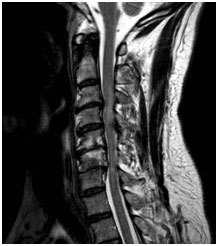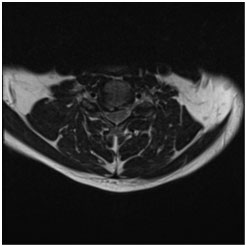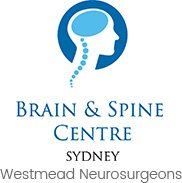Cervical Canal Stenosis
Cervical stenosis refers to narrowing of the spinal canal at the cervical spine. Compression of the spinal cord and nerve roots can cause pain, numbness and weakness which radiates to the arms and hands, commonly known as cervical radiculopathy. If the compression is significant, the spinal cord can also be affected by the compression resulting in deformation of the spinal cord with atrophy or bruising present ( myelomalacia). This may lead to significant loss of coordination of the upper and lower limbs with alteration in gait, commonly known as cervical myelopathy.
Cervical stenosis can be a combination of:
- Foraminal , involving compression of spinal nerve rootsemerging through the neuroforamen
- Central , involving compression of the spinal cord.
Causes
Usually age-related degenerative changes in the structure of the spinal canal
- Common in people over the age of 50 years
- Bulging of the intervertebral discs
- Thickening and infolding of the ligaments
- Osteophytes (bone spurs) arising from the posterior endplates and uncovertebral joints
- Calcification of the Posterior Longitudinal Ligament (OPLL)
- Instability with anterolisthesis (forward slip of vertebrae)
Symptoms
Majority of patients may be asymptomatic.
Some of the symptoms which may be associated with cervical stenosis include:
- Neck Pain, shoulder pain, scapular pain, interscapular pain, suboccipital headaches
- Stiffness in range of neck movement
- Arm pain, numbness, tingling, burning, heaviness
- Torso and leg pain, numbness, tingling, burning, heaviness
- Balance and coordination disturbances while walking or sitting
- Bowel or bladder dysfunction
Diagnosis
The diagnosis of cervical stenosis comprises of a physical examination along with a complete medical history of the patient. The doctor will examine the neck movement to evaluate for pain, numbness or weakness. Diagnostic imaging techniques such as X-rays, MRI scan, and CT scan help in confirming the diagnosis.


Treatment
Not every patient that has evidence of cervical canal stenosis requires surgery. The value of surgery will depend on the severity of compression and the associated symptoms, how it affects daily function, and any associated risk to the spinal cord in specific cases (eg younger person playing contact sports, older person with high fall risk).
Mild to moderate cases of cervical stenosis, can be usually managed by non-surgical methods such as pain medicine, spinal injection, exercise that maintain strength and flexibility and physical therapy.
In severe cases with progressive muscle weakness and loss of function due to compression of the spinal cord or nerves, decompression surgery is recommended. This procedure relieves the symptoms by decompressing the pressure on the nerve roots and spinal cord. The recommended operation is designed to improve the symptoms and function of the upper and lower limb. Any neck Pain, shoulder pain, scapular pain, interscapular pain, suboccipital headaches that the patient suffers from preoperatively may not improve substantially.
Some of the common surgical processes performed for the management of cervical stenosis include:
- Decompressive cervical laminotomy and foraminotomy for isolated nerve root compression
- Laminoplasty to expand the size of the central canal using small fixation plates to secure the posterior bony arch
- Laminectomy +/- fusion to decompress and correct/prevent progressive deformity
- Anterior cervical discectomy and fusion to remove the anterior compressive pathology
- Anterior cervical vertebrectomy and fusion to remove the vertebra if the compression is behind the vertebral body




